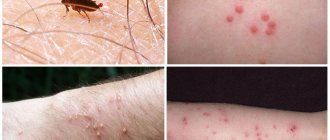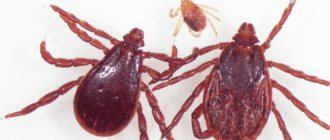Will a cat's tick fall off on its own?
Many people think that the most painless option, if a tick is already sitting on a cat, is to wait until it falls off on its own. In fact, it is in this situation that the risk of infection is maximum. As a rule, the parasite does not release infected saliva into the victim during the first 24 hours. In the next 24 hours, and especially before it falls off, it does this. This is why it is so important to remove the tick as early as possible.
How long a tick stays (sits) on a cat depends on its age and gender. Young nymphs and males only need a few hours (usually up to 6 hours) to drink blood. Adult females can sit for several days until they get so drunk that they increase in size several times. This is where the common misconception comes from: that males do not bite at all. They bite, but most often they are not even noticed. In this case, both males and even young nymphs can be infected and transmit the infection to the victim.
Main types of demodicosis
Depending on which species of tick causes the disease, the disease has a contagious (Demodex gatoi) or non-contagious (Demodex cati) form.
Types of pathology by degree of localization:
- localized - one area of the animal’s body is affected, sometimes several areas are affected, but there are no signs of the disease on the paws;
- generalized - several areas on the animal’s body are affected, and the cat’s paws are involved in the process - this form is more severe than localized. Veterinarians recommend sterilizing pets who have had this form due to the high risk of inheriting the subcutaneous mite.
Where to look for ticks on a cat?
Ticks are cunning creatures. They try to dig into a place where the cat itself cannot reach and where the bloodsucker most likely will not be noticed. The places where ticks bite cats are very diverse:
- on the neck;
- on the paw;
- on the body (body);
- on the tail;
- behind the ear;
- on the head;
- on the chin;
- between the paw pads;
- on the gums;
- on the mucous membrane of the eye.
Most often, the places where ticks dig into cats are invisible and hard to reach: neck, back, head, ear, armpits, stomach. Therefore, first of all, after a walk, to check your cat for ticks, look there.
If the parasite has just crawled under the cat's skin, it will look like a small black (brown) dot. Most often you can feel it with your fingers if you stroke the skin against the grain.
How to recognize ticks
Sometimes mites can be confused with a piece of skin or a wart, especially if we have never seen one before. These arachnids have eight legs, an oval body and usually a small head, which is usually embedded in the host's skin to suck blood and feed.
We can find them in different colors such as grey, brown or black, and the best way to distinguish them from a wart is to see if there are legs. These parasites typically feed around the cat's head, neck, armpits and between the pads of the feet, although they can also be found in any other part of the body.
Ticks are usually not visible to the naked eye unless they have fed in large numbers. Therefore, they will increase in size due to the blood they suck from the cat. The saliva of this parasite has anesthetic properties, so when it bites its owner, it does not feel anything and the cat does not scratch or show obvious signs of discomfort. When the animal leaves the area and the anesthesia wears off, the cat may feel discomfort and begin to scratch at the affected area.
If your pet is at risk of an infestation, daily brushing of the coat is the best way to eliminate its presence. When the tick has left the area, you can also identify a reddish and slightly inflamed bite, a sign that it was sucking blood there.
The cat was bitten by a tick - what to do?
So, we found out how to detect a tick on a cat. Now let's talk about what to do if you find out that a parasite has attached itself to a cat. Your job is to safely remove the tick from your cat. There are two basic rules.
What a tick looks like on a cat depends on whether it has drunk blood or not.
Rule one. You cannot use pseudo-folk methods such as smearing with oil or alcohol, igniting with a hot match, etc. While the tick is suffocating and dying, it will release a lot of saliva under the skin: the risk of infection will increase. You should also not try to remove the bloodsucker using a syringe and vacuum. This method most often does not work, even if you retract the piston very hard. You can watch the video of a man trying to pull out a parasite with a syringe and not succeeding, after which he uses tweezers, but incorrectly, and therefore the body comes off, but the head remains inside.
Article continues after advertisement
Rule two. When you pull out a tick, grab it as close to the skin as possible, that is, do not grab it by the butt or the middle of the body. You need to grab it quite firmly, but gently. Compressing the head on both sides will block the salivary flow. At the same time, you should not grab so hard as to provoke the bloodsucker to release a portion of saliva into the blood, as well as to tear his body and leave his head in the skin.
4 Effective Extraction Methods
- Using thread. The tick must be wrapped in thread and tied as close to the base as possible. Next, twist the thread as shown in the video.
- Using a special tool. Such a tool has a slot into which the tick should fall, after which it is pulled up, twisting it around its axis.
- Using regular tweezers. This method is more difficult for beginners, but as a rule, the most ordinary tweezers are at hand. Its edges should not be sharp so as not to cut the tick. And they shouldn't be too thick, because... The tick must be squeezed, it must not slip out and cannot be crushed. Hold the tick with tweezers as close to the skin as possible, then begin to pull it out with even force perpendicular to the skin, while twisting the tweezers clockwise or counterclockwise.
- Using an acaricide or insectoacaricide (drops or spray against ticks). Spray the tick and wait about 1-2 hours for the poison to take effect. At this time, make sure that your pet does not lick the bite site. A dead tick may or may not fall off on its own. Then, already dead, you will still have to pull it out with tweezers or thread.
After the tick is removed, it must either be burned, flushed down the toilet, or placed in a hermetically sealed container on cotton wool moistened with water if you want to take the tick for analysis. You can also take it for analysis, but most veterinarians consider this a pointless exercise, because by the time the test results arrive, the animal will already show symptoms if the tick has infected it. In addition, the fact that a tick is infected does not guarantee that it has infected the pet.
Having hidden or killed the tick, the bite site must be treated with either a soap solution or a disinfectant (chlorhexidine, betadine, alcohol, etc.). Keep an eye on this area for several days and contact your veterinarian if there are any changes.
If you are very afraid of pulling out a tick yourself, it is better to also take the animal to the veterinarian.
You can purchase a special tick removal hook in advance so that you have one at home just in case.
This button will open the iHerb online store website. Using our link you will receive a 5% discount.
BUY
Signs and symptoms of the lesion
The main areas of dislocation of the subcutaneous mite are considered to be the muzzle and the front part of the body of the pet. The parasite can live on the body of a new victim for quite a long time without symptoms. The first signs of damage will appear when the pet’s immunity decreases.
At this point, the owners begin to note:
- deterioration of the exterior;
- the appearance of keratinization areas in the eye area;
- impaired skin pigmentation;
- the appearance of dandruff over the entire area covered with hair;
- hair loss in clumps.
Sometimes pets develop acne and severe itching occurs in certain areas of the skin. The cat begins to scratch constantly, which leads to the formation of a blood crust. The height of the crust covering the wound can reach 12 mm. At the top of the growth there remains a small hole from which a stream of ichor continuously oozes. Areas of the skin with alopecia become covered with small ulcers, and the skin acquires a silvery tint.
The symptoms listed above occur because under the skin of a pet the tick digs passages along which it constantly moves. The products of its vital activity remain here. To examine the subcutaneous tick on the body of a four-legged pet, you do not need to make superhuman efforts. If you take a bald area of skin and make a fold out of it, you will even be able to remove the parasite yourself.
After examining the insect, it should be placed in an airtight container and transported to the veterinary clinic along with the injured cat. A specialist will be able to conduct a thorough diagnosis and outline an algorithm for the owner’s subsequent actions, which will help return the animal to a full life.
What to do if the tick's head remains in the cat?
Sometimes it happens that the tick was pulled unsuccessfully, or the animal chewed out the parasite itself - and the head of the tick remained in the skin. This is a bad situation, but not fatal. Maybe, at the moment of pulling, he managed to release infected saliva into the victim, or maybe he didn’t have time. You won't know this for the time being. Now the task is different: to remove the head of the tick so that it does not cause an inflammatory and purulent process.
The head is a dead foreign element that the cat’s immune system will definitely reject. This will cause an inflammatory reaction, then the area will fester. After some time, the head along with the pus will come out from under the skin on its own. But it’s better not to let it come to that.
To remove the tick's head, use tweezers with pointed tips that are convenient for picking up small objects. But do not cut or pick at the bite site: if you cannot pull out the head, it is better to consult a doctor.
Preventive measures
There is always a risk of demodicosis. Any situations that weaken the immune system will negatively affect the animal: stress, injury, special physiological conditions. Therefore, the main goal of preventing scabies in cats is to strengthen the immune system.
This includes the following measures:
- proper nutrition rich in proteins and vitamins;
- maintaining animal hygiene: brushing, bathing;
- maintaining the hygiene of the cat’s bedding, tray and toys;
- protecting your pet from drafts and dampness;
- periodic use of antiparasitic preventive drugs.
Whether it's a cat who loves to go for walks or a lazy couch potato, everyone is at risk of getting infected with a tick. It is easier to prevent the enemy from appearing than to neutralize him. Therefore, be attentive to your pet. If trouble still takes you by surprise, contact a veterinarian: treatment using a professional method for an animal is safer than the sophistications of traditional medicine. Don't let the problem start and don't let your guard down when making the first improvements.
A cat ate a tick - is it dangerous?
You should not allow your cat to bite ticks on his own, because... this increases the risk of infection and the risk of the head remaining in the skin.
Article continues after advertisement
The very fact of eating a tick, if the cat suddenly swallows it, poses little threat if the animal does not have wounds in the mouth and esophagus. But if they are present, an infection can enter the blood through these wounds from the tick along with saliva. Of course, this is only if the tick itself is infected and has also produced drool. The situation is unlikely, but it is better not to check.
Symptoms of a tick bite in cats
If you do not find a tick on a cat, but it falls off on its own, then the symptoms of the bite itself may not be noticed. The bite doesn't hurt, because... The tick releases an anesthetic substance under the skin. While eating, it may also not cause any discomfort. However, towards the end of the meal, discomfort and itching may occur. They can persist even after the tick falls off. That is, the consequences of a tick bite even without infection can manifest themselves in the form of redness, mild pain and suppuration if bacteria are introduced into the wound or the head of the parasite remains in it.
Some cats are allergic to mite saliva, ranging from mild redness and itching to severe pain, dizziness, fainting, and even anaphylactic shock. Such conditions must be corrected by a veterinarian.
But more often than not, the tick falls off unnoticed, and then lies in the apartment waiting for a new victim. This is the most dangerous situation, because... he can bite several family members at once. Bloodsuckers are able to wait a very long time for someone to turn up.
What is the danger of subcutaneous mite infection?
Infection with subcutaneous mites (red scabies or (by the name of the pathogen) demodicosis) threatens even those pets that never go outside.
The tick bite itself does not pose a danger to the pet, but it brings a lot of unpleasant sensations to it.
If treatment is not treated promptly, your pet may develop problems:
- aesthetic: skin lesions;
- loss of a significant part of the coat;
The severity of the skin disease depends on the type of microorganism infecting the animal and the breed of cat (some have a higher risk of infection).
Consequences of a bite and treatment
If a cat is bitten by an infected (encephalitis, etc.) tick, then the following symptoms are possible when infected:
- the cat is lethargic after a tick bite;
- suffers from poor appetite;
- the bite site turns red and a ring forms around it (a sign of Lyme disease);
- urine turns red or brown;
- the temperature has increased;
- and other.
These are all symptoms of infection. Even if you haven’t removed ticks from your cat in the near future, this does not mean that everything is in order. Be sure to show the animal to the veterinarian.
THE WEATHER IS UNFLIGHTABLE!
For some reason, many are convinced that ticks live on trees, especially birch trees. Therefore, it is believed that you simply do not stand under a tree, and the tick will not get you. It is a myth. The tick is not equipped with a parachute, therefore, it will not be able to shout “U-i-i-i!” make a reckless jump down, so he waits for his prey on the branches of a bush or simply on the grass. If the tick is very lazy, then it sits in the grass at the very edge of the roadside in order to occupy a place on you as quickly as possible.
Therefore, when in the forest, try to stay in the middle of the path, and make rest stops or overnight stays in clean, open clearings.
Remember also that ticks are especially active in cloudy weather; they do not like the sun; in the heat their activity decreases.
The cat was bitten by a tick - how to treat it?
If a cat, cat or small kitten is bitten by a tick, it does not mean that everything is lost. No treatment is required unless the bloodsucker is infected. According to statistics, only 25% of ticks are infected. But a bite from an infected tick does not always lead to infection. The earlier the owner noticed the parasite and removed it, the greater the chance of not getting an infection.
After the cat has caught a tick and it has been removed, it is necessary to monitor its condition and, in case of the slightest suspicion, contact a veterinarian. Be sure to warn the veterinarian about what happened the day before.
Many owners are interested in what to give their cat after a tick for prevention, that is, in case he does become infected. If there are no symptoms of illness, there is no need to give anything: the treatment itself is quite toxic, so there is no point in feeding the animal with medications every time the parasite is removed from it. You shouldn’t give interferons, which veterinarians sometimes recommend “just in case.”
Organizing independent treatment in case of symptoms is strictly prohibited. Only a veterinarian can make a correct diagnosis: many symptoms are the same for different diseases, so tests are needed. And self-treatment will only cause harm.
Article continues after advertisement
Pathogens of demodicosis and methods of infection
The causative agent of the disease is the subcutaneous mite - demodex. Actually, there are two types of subcutaneous mites (even three, but the third is currently poorly studied and not described): Demodex cati and Demodex gatoi. The first species (Demodex cati) always lives on the cat's body, in the hair follicles (the places where the hairs of the fur grow), and usually does not cause any trouble. This species is not at all contagious. But in some cases, such as illness, stress, decreased immunity of the kitten, this subcutaneous mite on the body multiplies excessively, accordingly, causing toothache and other inconveniences.
The second species (Demodex gatoi) is an infectious parasite. This subcutaneous mite is transmitted from a sick cat to another (but it is not dangerous for humans). It lives and reproduces in the stratum corneum of the skin (the surface layer consisting of keratinized cells). If this parasite gets on a cat's body, it can lead to illness. Although the body of healthy animals with strong immunity in most cases copes with subcutaneous mites on their own. Demodicosis occurs if the immune system is weakened for some reason.
How to keep your pet safe?
Check the coat after every walk. The simplest thing is to prevent the bite itself, because the tick crawls on the victim for quite a long time before biting. Along with the inspection, it is also better to comb the fur with a fine-toothed comb so that the tick remains on it if it is still crawling.
And don’t forget that you can only walk outside with protection: a collar, drops or spray against ticks and fleas. If your cat brings ticks home despite the presence of protection, change the product to a more effective one.
Rate and share!
Prevention
The main prevention is acaricidal agents and essential oils. When choosing preventative agents, it is important to take into account the weight and age of the individual.
Sprays
These products are sprayed onto the animal's fur. It contains chemical components that repel ticks. When handling, it is important to close the cat's eyes, ears and mouth. The main drugs are:
- buyer;
- hartz;
- agrovet protection.
They can be purchased at a veterinary pharmacy or clinic.
Collars
They are soaked in acaricides or essential oils to prevent bites. These collars are worn for a certain period of time, after which their effectiveness decreases to zero.
Drops on the withers
This method can be called the most effective. Drops of the product are applied to the cat’s withers. Active substances accumulate in the pores and glands and are distributed with secretions throughout the body. The most popular of them are Bars, Bayer or Hartz.
Drops on the withers against ticks











